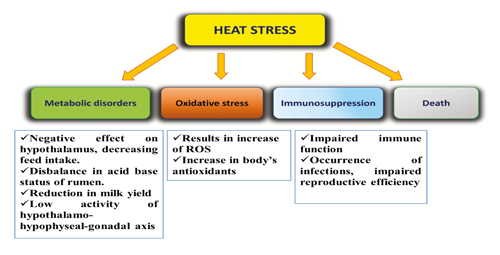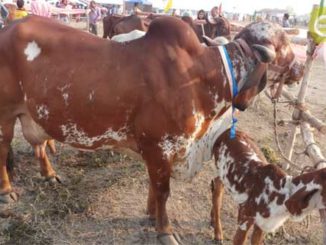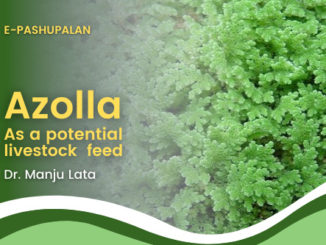Introduction
The varied climatic variables such as temperature, humidity, wind and rainfall are apprehended as the potential hazards in growth and production of livestock, causing discomfort and stress. Heat stress is produced by any combination of environmental conditions that cause the effective temperature of environment to be higher than the animal’s thermo neutral zone (Buffington et al. 1981) causing a breach between heat production within the body and its dissipation (Table 1). The air temperatures above 20-25°C in temperate climate and 25-37°C in tropical climate, enhance heat gain beyond that lost from the body and induce heat stress (Kumar, 2011). An increase in body surface temperature, respiration rate >60/min, heart rate and rectal temperature>39.0°C in succession affect feed intake, production and reproduction efficiency (Kadokawa, 2012). However, the homeotherm animals can resist heat stress up to some extent depending on species, breed and production ability.

Table 1. Thermo Neutral Zone for various livestock species
|
Species |
TNZ (0F) |
|
Cattle |
41-68 |
|
Calves |
50-68 |
|
Pigs |
50-80 |
| Goats |
40-68 |
| Sheep |
30-88 |
The temperature-humidity index (THI) is unified value that depicts integrated effect of air temperature and humidity linked with the level of heat stress. The THI is commonly used to evaluate the degree of heat stress on animals (Habeeb, 2018). THI levels of < 70 are comfortable, 71-74 – mild stress, 75-78 – stressful, 79-85 – severe stress and >86 are considered lethal to animals. However, factors such as genotype, coat type and color, diet type and composition, body condition, performance and health status were also known to influence thermal balance.
The Adverse Effect of Heat Stress on Animals
A reduction in dry matter intake, growth, feed conversion efficiency, reproduction, milk production and change in milk quality (Brown et al. 2005) are the changes observed when animals are exposed to heat stress. The changes in physiological, behavioural and biological responses are various quantifiable measures identified as indicators of heat stress in animals. Physiological response include increased sweating rate, respiration rate, breaths per minute, panting and body temperature (Mader et al. 2010). Alterations in posture, increased duration in shade area and body splashing at water troughs are the behavioural responses to heat stress (Young et al. 1993). The level of stress in animals is indicated by biological markers in blood (Collier et al. 2008).
The Effect on heat of animals during heat stress
Change in feed intake, acid base balance of rumen, oxidative stress and immune system
Increase in environmental temperature has a direct negative effect on appetite center of hypothalamus (Baile et al. 1974) causing decrease in feed intake. A decline in feed intake commence at air temperatures of 25-26°C in lactating cows (Rhoads, 2013) and reduces more rapidly above 30°C in temperate condition and at 40°C it may decline by 40%. The depletion is 22-35% in dairy goats (Hamzaoui et al. 2012) and 8-10% in buffalo heifers (Hooda et al. 2010).
During heat stress, an increase in respiration rate of animal promotes to rumen acidosis. Panting enhances the rate of CO2 to be exhaled. In order to have an efficacious blood pH buffering system, body needs to maintain a 20:1 HCO3− to CO2 ratio. Due to the hyperventilation-induced decrease in blood CO2, the kidney secretes HCO3− maintaining the ratio. This reduces amount of HCO3− that might be used to buffer and maintain a healthy rumen pH. In addition, panting leads to drooling of saliva and reduces in quantity required for the rumen. The reduction in saliva HCO3− content and declined amount of saliva entering the rumen make heat-stressed animal much more susceptible to subclinical and acute ruminal acidosis (Kadzere et al. 2002).
Oxidative stress also results in an increase of reactive oxygen species (ROS) in different cells and tissues of heat stressed animals. The antioxidant system of the body i.e catalase, SOD, glutathione etc increase as result of heat stress to provide protection against negative effects of ROS. The immune system is the major system of defense in the body which include WBC’s, RBC’s, Hb, PCV etc and their concentration get altered on thermal stress. The increased circulating cortisol in blood during heat stress cause an increase in heat shock proteins (HSPs) HSP functions as a danger signal, for immune system, encouraging the immune system to boost killing of pathogenic bacteria by neutrophils and macrophages against invading bacteria (Amaral et al. 2011).

The Effect on Production and Reproduction of Animals during Heat Stress
It is widely accepted that milk yields decline during hot weather conditions. Ambient temperatures of 29◦C have been reported to reduce milk yield of dairy cows by 23%. Additionally, it has been estimated that the energy requirement of the cow is 20% greater at 35◦C when compared with the energy requirements at 20◦C (Staples et al.2011). Reductions in milk yield during heat load are predominantly associated with reduced DMI. However, only 35% to 50% of the reduction in milk yield can be accounted for the decrease in DMI (Rhoads et al. 2009). Heat stress also has a negative association with milk fat and protein composition (Purwanto et al. 1990). The stage of lactation, diet type and composition, health status of the cow, cow genetics, and climatic conditions are all drivers of variation in milk protein (Lambertz et al. 2014). Further, heat stress reduced milk fat, protein and short-chain fatty acids while increase the long chain fatty acids in milk (Kadzere et al. 2002).
Heat stress reduces the length and intensity of estrus period and increase incidence of anestrous and silent heat in farm animals (Singh, 2013). A temperature rise of more than 2°C in buffaloes may cause negative impacts on follicular growth due to low or desynchronized endocrine activities particularly pineal-hypothalamo-hypophyseal-gonadal axis altering hormone functions (Upadhyay et al. 2009).
The Strategies to Reduce Heat Stress in Animals
Physical Modification of the Environment
Modification of microenvironment to enhance heat dissipation mechanism relieving heat stress is one of the most important measures to be considered in hot environment. Shading is one of the simplest, cost effective and cheapest method to modify an animal’s environment during hot weather. Shaded areas can reduce the radiant heat load of an animal by 30%, by simply blocking the sun (Mitlhoner et al. 2013). Trees are very effective natural shading materials providing shade and artificial shades can be provided by use of roofing materials like white galvanized or aluminum roof to protect from the effects of solar radiation. Alteration in the cow’s environment by use of evaporative cooling system with water in the form of fog, mist or sprinkling with natural or forced air movement cool the animal’s environment (Atrian et al. 2012).
Genetic Selection
An animal’s genotype is a major factor contributing to its susceptibility or tolerance to heat load. The Bos indicus breeds have greater heat tolerance compared to Bos taurus breeds. Cattle with shorter hair, hair of greater diameter and lighter coat color are more adapted to hot environments than those with longer hair coats and darker colors (Bernabucci, 2010). Genomic selection for heat tolerance have cumulative and permanent effects (Nguyen, 2016) in production species. The commercial viability of selection for heat tolerance needs to be evaluated. It is also important to consider that the selection for one trait may have negative consequences for another trait. It is generally accepted that improved heat tolerance comes at the cost of growth and reproduction (Gaughan, 2010).
Nutritional Strategies
Nutritional management strategies for cattle during hot conditions are focused on using
- Use of feed additives
- Altering feeding strategies
1 Use of Feed Additives
1.1 Electrolyte Supplementation
Bovines utilize potassium (K+) as the primary osmotic regulator of water secretion from their sweat glands. As a consequence, K+ requirements are increased (1.4 to 1.6% of DM) during the summer and this should be adjusted for in the diet (West, 2002). In addition, dietary levels of sodium (Na+) and magnesium (Mg+ ) should be increased as they compete with K+ for intestinal absorption (West, 2002). Current ranges for mineral supplementation during heat stress include 1.3 to 1.6% K, 0.35 to 0.4% Na, and 0.35% Mg of dry matter intake (Schneider et al. 1986).
1.2 Minerals and Vitamins
Antioxidant systems are believed to have evolved as a means of surviving in an oxygenated atmosphere by dealing with free radicals and the toxic products of their metabolism. Animal antioxidant defense mechanisms are based on the synthesis of numerous biological antioxidants. Under stress conditions, the internal antioxidant system network alone cannot deal properly with excess ROS formation and requires additional help from dietary antioxidant sources which include vitamin E, carotenoids, polyphenolics and Se (Sun, 2018).
Optimal levels of selenium (0.31-0.50 Se/kg DM) helps to maintain levels of endogenous antioxidants in tissues. Selenium protects tissues against oxidative stress, being component of glutathione peroxidase enzyme which destroys free radicals in cytoplasm (Calamari et al. 2011).
Supplementation of anti-oxidants like vitamin A, E, and C could scavenge either the maternal or embryonic ROS developed during heat stress. Supplementation with ascorbic acid causes a reduction of the respiratory quotient by emphasizing rise in fatty acid oxidation over the increase in protein-derived gluconeogenesis. The effect of α-tocopherol in the prevention of chronic disease is believed to be associated with oxidative stress during heat stress (Brigelius, 1999).
The micronutrient chromium facilitates insulin action on glucose, lipid and protein metabolism. The use of glucose predominates during heat stress, therefore supplementation with chromium may improve thermal tolerance and production in heat stressed animals. Soltan, 2010 reported that supplementation of chromium at 6mg/head/day in early lactating dairy cows reduced degree of weight loss, milk production and improved breeding rates.
Niacin, a peripheral vasodilator, helps to increase sweat gland activity in dairy cattle and also helps in reducing the body temperature. Niacin helps to alleviate heat stress both by increasing evaporative heat loss from the body and also by reducing the effects of heat at the cell level (Lundqvist et al. 2008). Cows undergoing mild to severe heat stress when fed with niacin at 12-24g/cow/d had reduced skin temperatures and increased milk production during summers as reported by Di Constanzo et al. (1997).
1.3 Rumen Fermentation Modifiers
Heat-stressed cows are typically hypoglycemic and have increased glucose disposal rates, which may be explained by increased basal and glucose-stimulated insulin levels (Wheelock et al., 2010). Monensin is a rumen modifier that increases the production of propionate (Schelling, 1984), the predominant gluconeogenic precursor in ruminants (Huntington, 1990). The increase in carbon conservation during fermentation is a key mechanism in how monensin increases feed efficiency in growing and lactating ruminants improving the glucose status of heat stressed ruminants (Baumgard et al. 2011).
Fungal culture and plant extracts may exert a positive action in rumen metabolism as well as in regulation of body temperature. Supplementation of live yeast improve nutrient digestibility and feed efficiency (Ferraretto et al.2012) and control ruminal pH (Bach et al. 2007). Under heat stress, supplementation of live yeast may increase nutrient flow to the small intestine. Shwartz et al. (2009) observed that the supplementation of a mixture of exogenous enzymes and yeast culture reduced rectal temperature of heat-stressed dairy cows, suggesting an action on thermoregulatory functions. Higginbotham et al. (1993) observed a lower rectal temperature in heat-stressed cows supplemented with Aspergillus oryzae.
2 Feeding Strategies
2.1 Feeding Time
Cows are often lethargic during the hottest parts of the day, therefore changing the feeding schedule to coincide with the cooler parts of the day (i.e. early morning and late in the evening) may be a good strategy.
2.2 Dietary Cation-Anion Balance
DCAD is an index of the acid-base status of the animal as it is the relative balance between the principle cations (potassium, sodium) and the principle anions (chloride, sulfur) in animal’s diet (Erdman, 2017). Increasing DCAB improved DMI and change of the equation (Na+K-Cl) using any of the three elements (Na, K, Cl) was equally effective in improving performance (Tucker et al., 1988).
Increasing DCAB raised blood pH, serum cation-anion balance and blood bicarbonate which are indicators of improved blood buffering. West et al. (1991) reported improved DMI and milk yield with increasing DCAB in both cool and hot environments, indicating a response regardless of environment. During heat stress conditions DMI was improved as DCAB was increased from 120 to 464 meq Na + K – Cl/kg feed DM, regardless of whether Na or K was used to increase DCAB (1992) suggesting that the DCAB equation is more significant than the individual element concentrations. Use of dietary buffers is a common practice, especially during hot weather, to make diets alkaline, providing further justification for the use of buffers during hot weather (West et al. 1987).
Table 2. List of feed ingredients and their dietary cation-anion difference (DCAD) (mEq/kg, dry basis)
|
Ingredient |
DCAD |
| Alfalfa | 466.3 |
| Cereal by product | 146.4 |
| Corn silage, normal (32-38% DM) | 229.4 |
| Grasses, hay, Mid maturity(55-60% NDF) | 320.0 |
| Legume forage | 512.6 |
| Soybean meal expellers, 45% CP | 531.4 |
| *DCAD = (Na++K+ ) – (Cl- ) | |
2.3 Fiber Feeding
Following a meal, heat production inside the animal’s body increases and this increase is called heat increment consisting of heat of fermentation and heat of nutrient metabolism (Maynard et al., 1979). The heat increment varies with the utilization efficiency of different nutrient present in feedstuffs. Heat stressed animals show a decrease of their energy utilization efficiency. This is related to the higher maintenance requirements to alleviate excess heat load (Bernabucci, 2012). A nutritional approach to minimize the negative effect of heat stress on DMI is the partial replacement of roughage NDF with more digestible NDF.
During heat stress fiber content of diets (30-35% of DM; West et al, 1999) should be minimized in order to reduce the metabolic heat load on the animal because fiber has a greater heat increment than does concentrate. Also, metabolism of acetate produces more endogenous heat than propionate (West 1999). The lower partial efficiency for acetate relative to propionate and glucose (Baldwin et al. 1980) and the change in heat of microbial fermentation leads to improved efficiency of animals during heat stress on low fiber diet. Physical factors derived from a higher fiber diet have greater hypophagic effects (Kanjanapruthipong et al. 2010). West et al, 1999 reported improved DMI, digestibility and milk yield when cattle was fed 30.2-33.8% NDF in diet during heat stress. Similarly, the total energy intake and diet digestibility may be a more important factor influencing metabolic heat production and resulting DM intake reduction than is dietary fiber concentration alone.
|
Species |
NDF level | Result |
Reference |
| Cattle | 30% DM | Higher milk production, lower body temperature and respiration rate | West, 1999 |
| Cattle | 42% DM | Lower intake, milk production and higher respiration rate | West, 2003 |
| HF | 25% DM | Improved intake and higher milk yield | Kanjanapruthipong, 2006 |
| Buffalo | 33% DM | Higher milk yield | Ahmed, 2014 |
2.4 Protein Feeding
Heat-stressed cattle were generally found in negative nitrogen balance, as consequence of the reduction in feed intake (O’Brian et al. 2010). The reduction in the feed intake can be counteracted by increasing protein content of diet, which can lead to an excess of nitrogen intake. When an alfalfa hay-based diet was increased from 14.3 to 20.8% CP using soybean meal, cows consumed more DM and produced more milk in summer without a corresponding increase in rectal temperature. However, energy cost to metabolise the excess of N above requirements is 7.2 kcal/g of N (Tyrrel et al. 1979). The process of detoxification of ammonia to urea by the liver generates heat high enough to raise the body temperature.
|
Species |
Protein level | Result |
Reference |
| Cattle | 16.1% | Higher milk yield | Huber, 1994 |
| Cattle | 19.1% | Increase DMI and higher milk yield | Thiangtum et al.2014 |
| Cattle | 20% | Higher DMI and milk yield | Hassan & Russel, 1975 |
Furthur, the ruminal degradability of dietary protein may also have an influence on the amount of ammonia generated in the rumen and detoxified in liver thus potentially adding to the heat load of heat-stressed cows. Cows fed high and low CP diets (18.4 and 16.1% CP) with high and medium degradability (65.1 and 59.3% of CP) during hot weather had lower DMI and milk yield when fed the high CP, high degradability diet (Higginbotham et al.1989). Apart from this, the amino acid profile of the protein diet particularly the lysine content helps in ameliorating heat stress in animals. The intake of N beyond the requirement of the cow will need to be incorporated into urea and excreted in the urine. This process demands energy and generate heat putting an additional drain on the animal at a stressful time.
2.5 Feeding Fat
The heat increment for fats is lower than nutrients like starch and fiber; generating less heat load on the animal than the other major feedstuffs. Dietary fatty acids appear to be an ideal supplement during heat stress as the utilization efficiency of fats for milk production is higher and its high energy density (2.25 times greater) as compared to carbohydrates. This improvement in efficiency is partly due to production of methane by ruminal microbes during digestion (Chilliard, 1993). This results in more metabolizable energy left from the diet for the animal. Fats are not digested in the rumen so production of heat in the rumen from fat digestion is minimal. Also, the fat for milk fat synthesis or body fat storage can be provided directly by the fat supplement so that the tissues including the mammary gland do not need to make fat from the small building blocks of acetic acid and butyric acid. Lactating dairy cows are more susceptible to ruminal acidosis during heat stress conditions. Fat may be added to a higher fiber diet in order to maintain the energy density of the diet. Therefore fat supplementation (2.5% of dietary DM) may be a good strategy while using higher fiber diets in order to minimize the risk of ruminal acidosis and maintain milk production.
2.6 Water
Water is the nutrient of greatest importance in hot weather. Animals drink more water under heat stress condition as it aids in cooling the body core and its metabolism is closely linked to the thermoregulatory requirements of the ruminant. In addition, the cow loses additional water from the skin and lungs as they work to minimize rise in body temperature. Intake of drinking water by lactating cows increased 29% and loss of water via the skin and respiration increased 59% and 50% respectively when ambient temperature increased from 64.4 to 86°F (Collier et al.,1982). Providing cool, clean water in ad libtum amounts is simply good management and any restriction may cause the drop in milk production. The cows will become hotter than normal and DM intake will decrease to a greater extent as intake of DM and water are closely linked.
Conclusion
The periods of high air temperature coupled with high relative humidity compromise the ability of animal to dissipate excess body heat which affects feed intake, milk production and reproductive efficiency and ultimately reducing profitability. However, minimizing body temperature and electrolyte loss via skin secretion greater feed intake and the gross efficiency with which dietary nutrients are used by the cow for performance could be improved. Use of various management strategies like physical modification of micro environment, genetic selection and feeding management could help alleviate the effect of heat stress. Increasing energy density of diet, adding mineral supplements, use of feed additives and providing ad lib drinking water have served to enhance animal performance under hot weather.






𝓖𝓸𝓸𝓭 𝓪𝓻𝓽𝓲𝓬𝓵𝓮,
Dr Belsare ..Thank you so much sir
To Dr Jacob ..thank you for raising this point. The author agrees with your views that TNZ varies at temperate and tropical climate. Also the source of information is through the Lowa state university extension and RCI Australia. Thank you.
To DrIslam.. the article is purely written to give a knowledge on what aspects of diet could be looked upon to minimize the stress level of animal which will definately be helpful to a farmer. As far as practical knowledge is considered, the article will be furthur improved as and when the author gets to experience and work at field level. Thank you for highlighting the improvements to be made.
Being a veterinarian, working as a stud Veterinarian for Sex semen production, this post is theoretical rather than any field based knowledge.I am working in stud since last 26 years , the post will not help even poor lay farmers. Before publishing any post which may helpfull to poor farmers,expend time in stud to get hand on experience,collect data and take practical view of Stud Veterinarian and animal handler.
The value of TNZ given for each species in °F is too low. Further, the TNZ would depend on whether the animal is in temperate climate or tropical climate. No reference is attached to the Table to indicate the source of information. The author may verify the validity of the information provided on TNZ
Very good article, gives detail information. Thanks